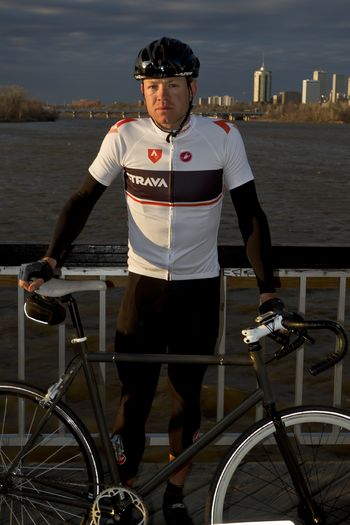
Before you brag to your buddies about how hard you’ve been training, meet Matt Carnal. Over 26 days in January, this 32-year-old from Tulsa, Oklahoma, took part in—and won—the . Sponsored by the ride-tracking website Strava, the event pitted riders against one another online to see who could go the biggest. Carnal notched 3,347 miles, obliterating the nearest competition by almost 1,000 miles. That’s an average of 128.7 miles a day for 26 consecutive days. We caught up with Carnal to see how he did it—and why?
–Aaron Gulley
OUTSIDE: You rode 3,347 miles in January? Seriously? Is that even possible?
Matt Carnal: Yep, seriously. And for the entire month of January [Editor: The Base Mile Blast ran from January 6 to 31] I totaled 3,557 miles, with only two recovery days and one forced travel day, which I was not happy about. You can if you want proof. I believe that others can meet and break my records. I hope I inspire people to do it.
How did you manage?
First and foremost, I kept smiling. That helped my body remain in an optimal state. It really works. Then I treated the Blast as my job. I awoke in the morning with a goal and fulfilled it. Like any job, there were days that were much more difficult to “go to work” than others. But I assumed an uncompromising commitment to keep my days structured. It was ride, eat, ride, eat, ride, eat, work, recover, sleep, and repeat—without deviation.
Another part of the equation was mental. I got away from mind-numbing distractions like television and trivial conversations and spent as little time as possible in a car. Being outside and close to nature was one of the main factors in my success.
Riding in January in Tulsa—isn't it cold there?
Yes, Tulsa can be cold in January. I was fortunate enough to spend 15 days of the Blast in California, where it was warmer. Yet the more time you spend outside, the more conditioned your body is to cold. There were a couple of rainy days in Tulsa when I was a little uncomfortable. But I'm comfortable being uncomfortable!
What gear do you use to keep warm?
In winter when conditions are poor, I prefer to ride my fixed gear bike. My legs are always spinning, which keeps me warm. The other nice thing about riding a fixie in winter is there is less to clean up when you get home.
As for apparel, I wear plastic bags over my socks, then shoes, then thermal booties over the shoes. Moving up the body: I wear leg warmers underneath thermal bibs, and on top, three or four layers beneath a wind stopper. I wear a beanie, ski goggles, and two pairs of gloves.
Why did you do it?
Why not? I wanted to see what I could do.
I did it for the smiles I brought to others while doing something I love more than anything. The bike sets me free. It brings me joy, passion, and adventure I could never experience in a traditional job. There are so many wonderful things out there to see when we get away from the meaningless things society emphasizes.
I also thought a lot about friends who are battling ailments, and friends who have been killed while riding. I remember how fortunate I am to have these experiences riding, experiences they can’t have. It’s the appreciation for the opportunities life has provided me that keeps me driven not to waste them. I want to see new places, experience new things, to share with others—to live as if I truly believe I'm doing what I'm meant to do.
And I did it as a precursor to (RAAM), which I’m going to do in 2013.
Why RAAM?
I'll compete in RAAM because it's a breathtaking challenge. I have to laugh because ultra-cycling is so new to me. I did my first 400-plus-mile ride in June 2004, three days after I got my first road bike. In 2010, I rode across the United States. I was logging close to 100 miles a day towing a 40-pound trailer. I met a few people who said I should do RAAM someday, so I decided give it a go. The fact that RAAM has been dominated for so long by Europeans really ignited a flame in me to win it for America.
If you log 3,500 miles in a month almost 18 months ahead of RAAM, what is a “hard” month going to look like when you get closer to the event?
Without disclosing specifics of my 18-month training plan, I can tell you there are a few altitude blocks, sleep deprivation blocks, and volume blocks. A hard month? Five thousand miles with 300,000 feet of climbing is not out of the question.
Do you have time to follow others on Strava? has provided me with tools that were essential to win this challenge and with valuable external motivators. During the challenge I followed the leader board to see what others were doing, and I responded to comments. But I like to spend most of my time generating Strava files.